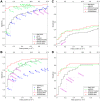GUESS-ing polygenic associations with multiple phenotypes using a GPU-based evolutionary stochastic search algorithm
- PMID: 23950726
- PMCID: PMC3738451
- DOI: 10.1371/journal.pgen.1003657
GUESS-ing polygenic associations with multiple phenotypes using a GPU-based evolutionary stochastic search algorithm
Abstract
Genome-wide association studies (GWAS) yielded significant advances in defining the genetic architecture of complex traits and disease. Still, a major hurdle of GWAS is narrowing down multiple genetic associations to a few causal variants for functional studies. This becomes critical in multi-phenotype GWAS where detection and interpretability of complex SNP(s)-trait(s) associations are complicated by complex Linkage Disequilibrium patterns between SNPs and correlation between traits. Here we propose a computationally efficient algorithm (GUESS) to explore complex genetic-association models and maximize genetic variant detection. We integrated our algorithm with a new Bayesian strategy for multi-phenotype analysis to identify the specific contribution of each SNP to different trait combinations and study genetic regulation of lipid metabolism in the Gutenberg Health Study (GHS). Despite the relatively small size of GHS (n = 3,175), when compared with the largest published meta-GWAS (n > 100,000), GUESS recovered most of the major associations and was better at refining multi-trait associations than alternative methods. Amongst the new findings provided by GUESS, we revealed a strong association of SORT1 with TG-APOB and LIPC with TG-HDL phenotypic groups, which were overlooked in the larger meta-GWAS and not revealed by competing approaches, associations that we replicated in two independent cohorts. Moreover, we demonstrated the increased power of GUESS over alternative multi-phenotype approaches, both Bayesian and non-Bayesian, in a simulation study that mimics real-case scenarios. We showed that our parallel implementation based on Graphics Processing Units outperforms alternative multi-phenotype methods. Beyond multivariate modelling of multi-phenotypes, our Bayesian model employs a flexible hierarchical prior structure for genetic effects that adapts to any correlation structure of the predictors and increases the power to identify associated variants. This provides a powerful tool for the analysis of diverse genomic features, for instance including gene expression and exome sequencing data, where complex dependencies are present in the predictor space.
Conflict of interest statement
The authors have declared that no competing interests exist.
Figures




References
-
- Brown PJ, Vannucci M, Fearn T (1998) Multivariate Bayesian variable selection and prediction. J Roy Stat Soc B 60: 627–641.
-
- Denison DGT, Holmes CC, Mallick BK, Smith AFM (2002) Bayesian Methods for Nonlinear Classification and Regression. New York: Wiley.
-
- Monni S, Tadesse MG (2009) A stochastic partitioning method to associate high-dimensional responses and covariates (with discussion). Bayesian Analysis 4: 413–436.
Publication types
MeSH terms
Grants and funding
LinkOut - more resources
Full Text Sources
Other Literature Sources
Molecular Biology Databases
Miscellaneous

